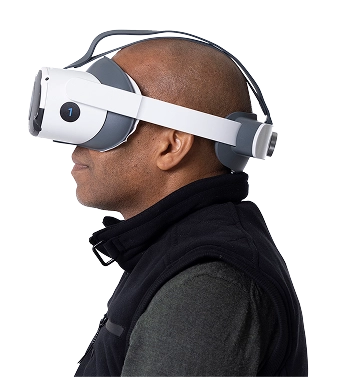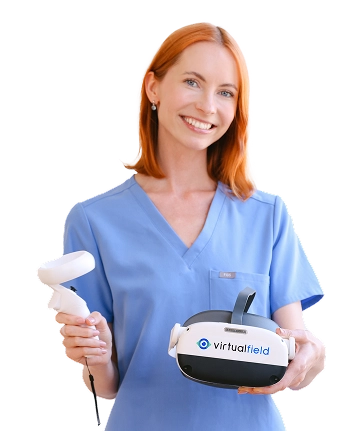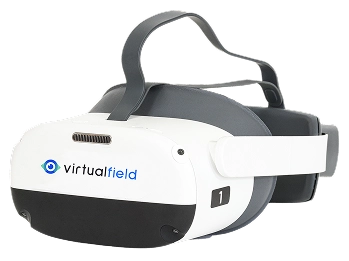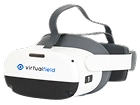Most visual field exams focus on central or full-field loss, often overlooking the upper hemifield. If your patients report symptoms of superior vision loss or you need to assess functional eyelid obstruction, the Superior 64 visual field test is a precise and clinically trusted method.
This hemifield ptosis test samples 64 points above fixation—making it one of the most detailed upper-field assessments available. While not a routine screening, it plays a vital role in oculoplastic workups and insurance documentation for eyelid surgery.
This test is a suprathreshold screening protocol that’s typically conducted with a tabletop perimeter. It’s not part of standard screenings, and not every practice offers this specialty test. While Virtual Field’s Superior 36 visual field exam is an accessible way to measure ptosis, the Superior 64 is still relevant for practices managing patients with functional eyelid issues or problems with the upper visual field.
Superior 64 Visual Field Exam Overview
The Superior 64 is a suprathreshold test that samples 64 points in the upper hemifield, extending up to 60 degrees above fixation. This test enables practitioners to assess the entire upper field of vision and collect the most accurate data on ptosis and dermatochalasis possible.
Ptosis, also known as blepharoptosis, is a common condition that causes a visibly drooping eyelid. Most often related to age, it can be both a cosmetic and a quality-of-life complaint. Similarly, patients with dermatochalasis may have so much excess skin on the upper eyelid that it can interfere with their superior visual field. In most cases, the Superior 36 test can provide sufficient information for oculoplastic referrals. However, to meet some CMS or insurance documentation requirements, more data may be requested, which is where the Superior 64 comes in.
Compared to the Superior 36, the Superior 64 is more robust. As the name implies, the Superior 64 collects nearly twice as many data points as the Superior 36, and it is more sensitive in detecting functional vision loss due to ptosis or dermatochalasis. It is often preferred for surgical documentation, but it requires more time to complete. If you offer oculoplastic surgery or plan to refer patients, this test will likely provide all the necessary details for insurance coverage.
This exam is commonly administered using a tabletop perimeter and is considered a specialty eyelid surgery visual field device in clinical workflows.
Academic references and clinical validation
A study of the HFA Superior 64 confirmed that this visual field exam can detect the amount of superior visual field loss caused by ptosis.
This article, published by the National Library of Congress, discusses acquired blepharoptosis: prevalence, diagnosis, and current treatment options.
This OD's Guide to Ptosis Workup provides guidelines on monitoring and evaluating ptosis patients, with an emphasis on acquired forms.
Virtual Field is proud of its commitment to the highest security and quality assurance standards. We are SOC 2 Type 2, HIPAA, FDA, and Health Canada compliant.


30 days free.
No strings attached.
We are confident you’ll love Virtual Field just like the 2,000 doctors who have already made the switch.
The Hemifield Ptosis Test at a Glance: Superior 64
This test can be conducted using a tabletop perimeter device, such as the Humphrey Field Analyzer. In this test, the patient is presented with 64 suprathreshold points in a hemispheric grid, and they’ll be asked to respond when they can see the stimuli.
This test takes several minutes per eye, so it requires dedicated time in your workflow. Although it requires more chair time than other ptosis screenings, the Superior 64 visual field test provides the robust detail needed for confident diagnosis and surgical justification.
Pros and Cons of the Superior 64 Hemifield Visual Field Exam
The pros and cons that follow can help guide you toward the ideal scenarios to incorporate this test into your patients' diagnostic assessments.
Pros
More abbreviated than a complete visual field exam but more robust than the Superior 36, this test collects very detailed information within a specific region of the visual field.
For patients who need blepharoplasty, the Superior 64’s data will provide quality information to guide treatment.
Test results meet Medicare and insurance documentation requirements for functional eyelid surgery.
Often used as a hemifield ptosis test in pre-surgical workups.
Suitable for documentation using a tabletop or portable hemifield perimeter.
Cons
The Superior 64 lacks detailed decibel-level mapping and only measures the presence or absence of vision.
This test is specifically designed to measure the superior visual field; therefore, it is not applicable in general screenings and cannot replace other visual field exams.
Not typically available on all eyelid surgery visual field devices
Cannot be substituted for full-field assessments in non-ptosis-related conditions
Ocular Conditions Identified by the Superior 64 Visual Field Test
The Superior 64 visual field exam is especially valuable in screening functional loss caused by eyelid or brow abnormalities in the upper hemifield.
Ptosis (Blepharoptosis)
Weak upper eyelid muscles can lead to noticeable drooping. This, in turn, can lead to interference with the superior visual field. The Superior 64 is specifically designed to identify obstructions.
Brow Ptosis
Patients with very low-lying eyebrows can experience a reduced superior visual field. This test can document the condition and inform corrective surgeries.

11.5%
11.5 % of adults ≥50 have blepharoptosis
30 – 70
It's projected that roughly 30 – 70 babies are born with congenital ptosis in Canada each year
Dermatochalasis
“Hooded” upper eyelids with excess skin can obstruct vision. Taping and testing with the Superior 64 can reveal the extent of this obstruction.
Nonarteritic Anterior Ischemic Optic Neuropathy (NAION)
Altitudinal defects, both superior and inferior, can sometimes be related to NAION. You can map and track visual field loss with precision using the Superior 64.
30 days free.
No strings attached.
We are confident you’ll love Virtual Field just like the 2,000 doctors who have already made the switch.

Billing and Coding for the Superior 64
Visual Field Exam
The Superior 64 screening pattern qualifies as an extended visual field test under CPT 92083. Reimbursement under the CMS Physician Fee Schedule can be between $25 to $80 per eye. Your actual reimbursement will depend on practice location, setting, and other factors.
When should you use the Superior 64 visual field hemifield test?
While the Superior 64 visual field exam is not used routinely, it becomes essential when diagnosing and documenting upper eyelid obstruction. Whether you're preparing a surgical referral or measuring post-operative improvements, this hemifield ptosis test supports precise, reimbursable care. After surgery, you can use this test to monitor recovery.
Is the Superior 64 required for driver’s licenses?
No, this test is used specifically for upper visual field testing and isn’t applicable for driver’s licenses. Standard acuity tests, such as the Esterman or Fullfield 120, should be used to meet licensing requirements.
Start Conducting Comprehensive Eye Exams with
Virtual Field
Although the Superior 64 visual field exam isn’t currently available on Virtual Field, you can conduct a wide range of visual field screenings using our portable hemifield perimeter. With a patient-friendly headset, fast test times, and seamless EHR integration, Virtual Field helps you deliver accessible, modern care for patients with eyelid-related vision loss.Use the Superior 36 for routine ptosis documentation, and refer out for the Superior 64 when more extensive insurance reporting is required.
Want all 23 exam guides in one place?
Download our comprehensive guide for 160+ pages of insights.
FAQs
1. How does the Superior 64 pattern prove functional ptosis for insurance?
2. What taped-versus-untaped improvement do insurers require?
3. Is Superior 64 billed differently from Superior 36?
4. Why doesn't Virtual Field offer the Superior 64 visual field test?
Ready to get started?
Schedule a demo or begin your 30-day free trial of Virtual Field to try our EOM exam in your practice.

Questions? Contact sales@virtualfield.io talk to a Virtual Field expert today.


